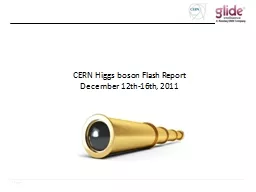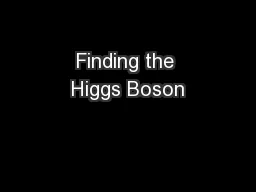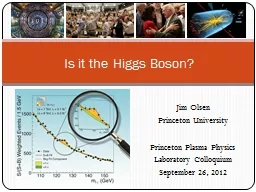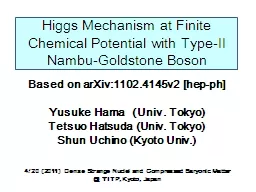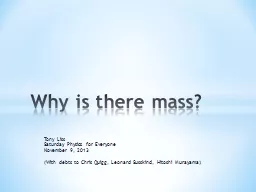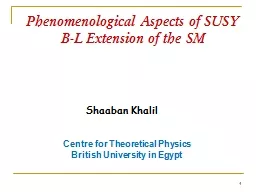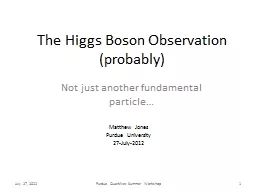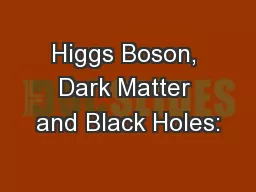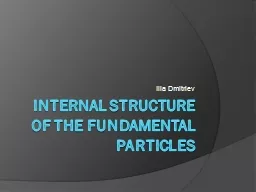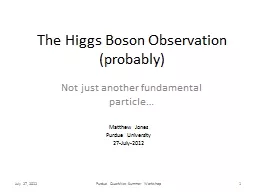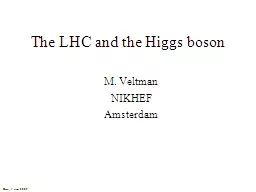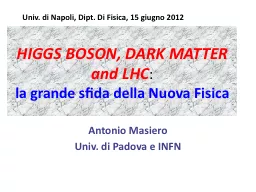PPT-CERN Higgs boson Flash Report
Author : cheryl-pisano | Published Date : 2016-07-25
December 12th16th 2011 Table of Contents CERN Higgs boson Flash Report Executive Summary amp Findings 34 Background 5 Preannouncement overview 6 Announcement overview 7
Presentation Embed Code
Download Presentation
Download Presentation The PPT/PDF document "CERN Higgs boson Flash Report" is the property of its rightful owner. Permission is granted to download and print the materials on this website for personal, non-commercial use only, and to display it on your personal computer provided you do not modify the materials and that you retain all copyright notices contained in the materials. By downloading content from our website, you accept the terms of this agreement.
CERN Higgs boson Flash Report: Transcript
December 12th16th 2011 Table of Contents CERN Higgs boson Flash Report Executive Summary amp Findings 34 Background 5 Preannouncement overview 6 Announcement overview 7. (s). Why do we need them?. What do they look like?. Have we found them?. γ. Quantum Electrodynamics. predicts one . massless. . spin-1. . gauge boson. PHOTON. g. Quantum . Chromodynamics. . predicts . 2014. Overview. Review of the Standard Model and the Higgs boson. Creating Higgs bosons. The discovery of a “Higgs-like” particle on July 4, 2012. Is it really the Higgs boson?. The Standard Model. Princeton University. Princeton Plasma Physics Laboratory Colloquium. September . 26, . 2012. Is it the Higgs Boson?. Many Princeton undergraduate students have worked on the CMS experiment over the years. . with Type-II. Nambu. -Goldstone Boson. . Based on arXiv:1102.4145v2 [. hep. -ph]. Yusuke Hama. . (Univ. Tokyo). Tetsuo . Hatsuda. (Univ. Tokyo). Shun Uchino (Kyoto Univ.). 4/20 (2011). . Dense Strange Nuclei and Compressed Baryonic Matter. Saturday Physics for Everyone. November 9, 2013. (With debts to Chris Quigg, Leonard Susskind, Hitoshi Murayama). Why is there mass?. What . is mass?. Mass is . stuff. Mass is the . stuff. that gravity acts on. . Aungshuman. . Zaman. Department of Physics and Astronomy. Stony Brook University. October 11, 2010. What Is This Talk All About. Why is the search for the Higgs Boson important?. Gauge theory and standard model.. B-L Extension of the SM. 1. Shaaban. Khalil. Centre . for . Theoretical . Physics . British University in Egypt. Outline. TeV. scale . B-L. : Minimal bottom-up extension of the SM. B-L. signatures at LHC. (probably). Not just another fundamental particle…. July 27, 2012. Purdue QuarkNet Summer Workshop. 1. Matthew Jones. Purdue University. 27-July-2012. The Standard Model. Charge. 1. st. family. 2. Revolutionizing the Laws of the Universe with the LHC. Ashutosh Kotwal. Duke University. Egyptian Pyramids: Monument for Glory. Great Wall of China: Monument for Defense. Monument for Knowledge: The Large . Ilia. . Dmitriev. Codes of the particles. Every known fundamental . fermion. or boson can be expressed as 8-bit code.. The codes have the structure of two bit triangles accompanied with the bit pair.. (probably). Not just another fundamental particle…. July 27, 2012. Purdue QuarkNet Summer Workshop. 1. Matthew Jones. Purdue University. 27-July-2012. The Standard Model. Charge. 1. st. family. 2. M. Veltman. NIKHEF. Amsterdam. Cern, 4 dec. 2009. Higgs search. Higgs hunting. In 1974 I asked myself: if the Higgs is all around us in the vacuum. we should really be able to see it. Since the Higgs field in the vacuum. and LHC. :. la . grande. . sfida. . della. . Nuova. . Fisica. Antonio Masiero. Univ. di Padova e INFN. Univ. di Napoli, . Dipt. . Di . Fisica. , 15 . giugno. 2012. FCNC, CP ≠, (g-2), (. ). . agitating. . that a Revolution in the field of particle physics is inevitable. . ⇒ . Discovery of “Higgs Boson” = . The July revolution has started. ⇒ . This is just a start of an enormous revolutionary era overwhelming the Standard Model = .
Download Document
Here is the link to download the presentation.
"CERN Higgs boson Flash Report"The content belongs to its owner. You may download and print it for personal use, without modification, and keep all copyright notices. By downloading, you agree to these terms.
Related Documents

